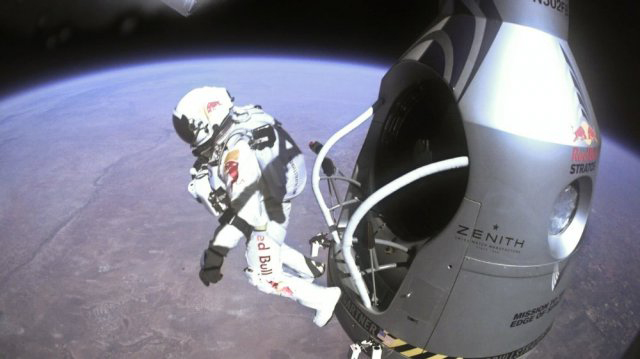'Fearless Felix' historic space jump has Natick ties

Last weekend, the world watched as "Fearless" Felix Baumgartner made his epic descent from a balloon 128,100 feet above the Earth.
But what the world didn't know at the time is that the technology used to monitor Baumgartner's heart and respiratory rate has ties to Natick, Mass.
The Equivital Life Monitor manufactured by Hidalgo Ltd. in Cambridge, U.K., which Baumgartner strapped on before his record-breaking jump, was supported and developed with the assistance of researchers at the U.S. Army Research Institute of Environmental Medicine's Biophysical and Biomedical Modeling Division, in Natick.
This device monitors a patient's heart and respiratory rates, skin temperature, oxygen saturation, body position and motion. That data can then be transmitted to a smartphone or computer for analysis.
Today, the Life Monitor is used in a wide range of applications, including use by hospital patients, subjects of pharmaceutical studies, athletes and military personnel. This has become possible because of the research conducted at USARIEM.
USARIEM began working with Hidalgo in 2000 after conducting a down select process from which Hidalgo was chosen from four potential collaborators.
Researchers at USARIEM were looking for a company that could help them develop a wearable monitoring system that could collect physiological data, such as heart and respiration, from Soldiers doing a variety of physical tasks.
"We conducted a series of lab comparisons to find out which vendor would meet our research needs the best," Anthony Karis, a USARIEM research scientist said. "In the end it was Hidalgo that gave us the most flexibility in terms of collecting the data we needed for our mathematical model development."
Research conducted at Fort Polk, La., by USARIEM in 2003, demonstrated the important role user acceptability and comfort play in the successful development of a wearable life signs detection system. Any successful system must be compatible with the uniform and equipment worn by the military. In other words, Soldiers have to like it.
"If a Soldier perceives that his/her comfort, performance, morbidity, mobility and lethality will be negatively affected by a certain piece of equipment, then the Soldier will be unlikely to wear it despite its potential benefits," the report's author, Dr. Beth Beidleman, a research physiologist at USARIEM, wrote in the transcript of the study. "It is imperative to identify a physiological status monitoring design concept that is acceptable to the Soldier."
In 2004, as part of the Warfighter Physiological Status Monitoring Initial Capability Program, USARIEM gave Hidalgo a list of specifications needed to develop a small form factor cloth chest belt system to be used as part of the Future Force Warrior Program.
From there, Hidalgo developed a chest belt to meet the comfort needs of warfighters while providing the redundant measures of heart rate, respiration rate and activity needed for research. As a result, the Life Monitor was developed and received FDA pre-market approval in 2006.
"The device was comfortable enough to be worn by warfighters during training and provided us with reliable high quality data, that we could use to develop our health state estimation algorithms," Mark Buller, deputy division chief for BBMD said. "Now we had this FDA approved device that gave us high quality data in the field."
Buller, who has been the principal investigator for this device since its inception, said that these new capabilities provided USARIEM researchers with a comfortable monitor that could be fielded directly to the warfighter. This monitor not only put warfighters' wellness demographics at their commander's fingertips, it led to a change in doctrine.
In 2008, USARIEM was contacted by the program manager for the Marine Expeditionary Rifle Squad who was concerned that Marines in Iraq were getting too hot in the blazing desert heat.
"The program manager at the time said he knew the Marines were getting hot," Buller said. "But he wanted to know just how hot they were getting during missions."
So USARIEM sent the Life Monitor to Iraq to answer this question.
"Our study showed that these Marines were getting so hot, with being overloaded with protective gear, ballistic equipment and flame protection that they were right at the edge of their physical capabilities in terms of heat stress," Buller said.
The results of this study, according to Buller, were used by the Marines to allow heat to be considered as a factor in determining the amount of ballistic protection a Marine would wear during a mission.
At the same time, Marines provided feedback that the monitor's placement of sensors in the center of their chest was uncomfortable once they donned body armor. Researchers took this feedback and worked with Hidalgo to redesign a second generation monitor that was more comfortable.
These improvements helped lead to the final product that Baumgartner wore during his descent.
"The reason that Felix could be monitored in such an extreme environment is because of years of work to meet USARIEM's goal of providing warfighters with real time health state feedback," Buller said. "The original development, testing and improvement that we have done has enabled a very versatile monitor."
Buller said that BBMD's goal going forward is to use this device along with similar devices and algorithms to provide real time health state information to warfighters, commanders, and medics. Karis agrees.
"Ultimately, this technology strives to help us decrease heat casualties and optimize the amount of time a person can work at their full potential," Karis said. "To think that this was the same device that Baumgartner wore during his descent is really cool."














